Abstract
The transfer of p,p'-DDT (1,1,1-tricholoro-2,2-bis(4-chlorophenyl)ethane) and its metabolites to infants via breast-feeding was studied in an area of KwaZulu, South Africa, where DDT is used to interrupt malaria transmission. Samples of whole blood were collected from 23 infants, together with samples of breast milk from their respective mothers. The mean sigma DDT (total DDT) in the whole blood was 127.03 micrograms.l-1 and that in the breast milk, 15.06 mg.kg-1 (milk fat). The % DDT (% DDT of sigma DDT) was significantly higher in the infant blood than in the breast milk (P less than 0.05). A multiplicative regression analysis indicated that sigma DDT increased significantly (P less than 0.01) in infant whole blood with infant age. Multiple regression showed that 70.0% of the variation in sigma DDT was due to the variation in parity of the mother, age of the infant, and the sigma DDT in breast milk. These variables accounted also for 76.3% of the variation in p,p'-DDE but only for 38.2% of that in p,p'-DDT. Organochlorines were therefore largely transferred to the infant from the mother, with DDT in the environment playing a secondary role.
Full text
PDF
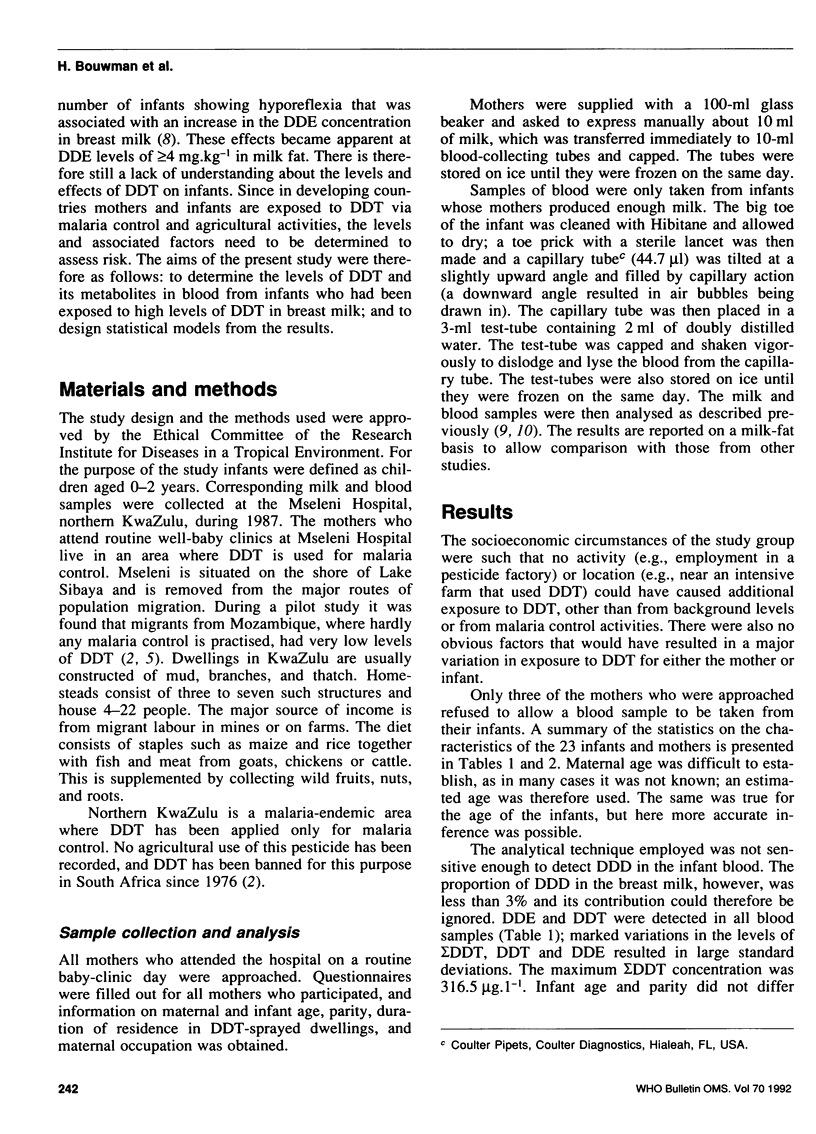

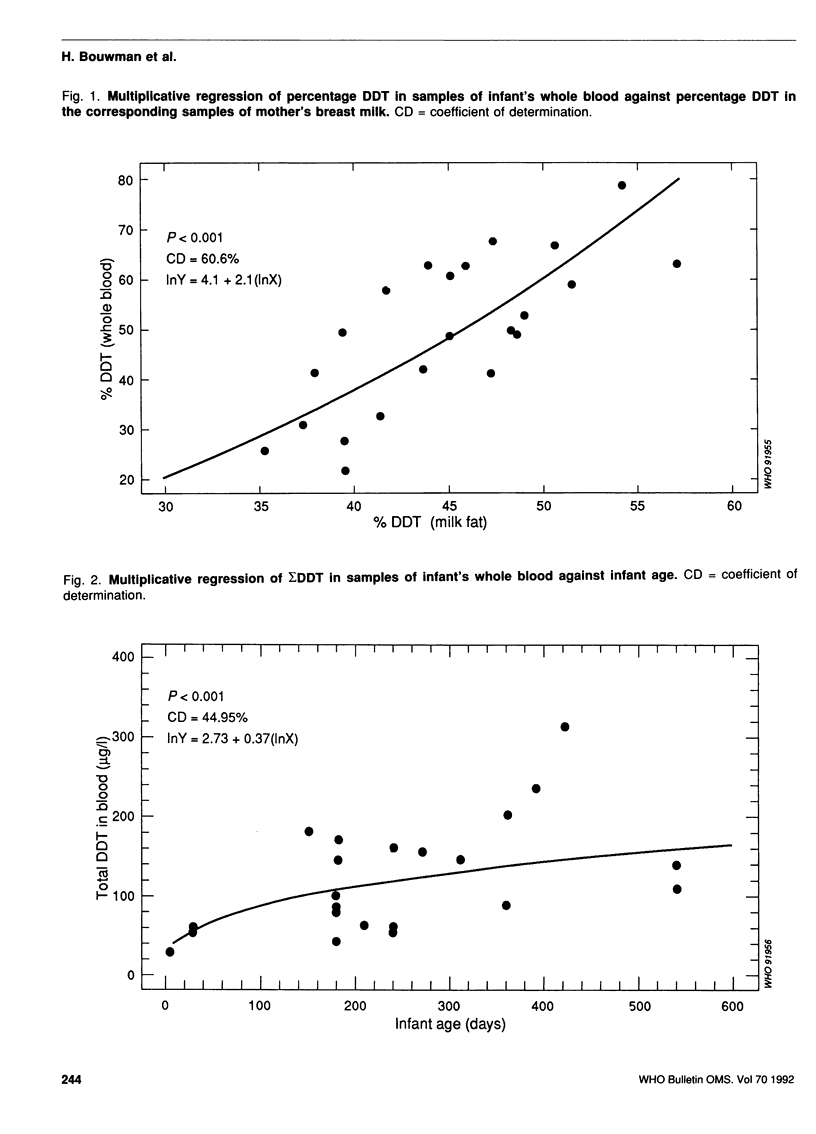

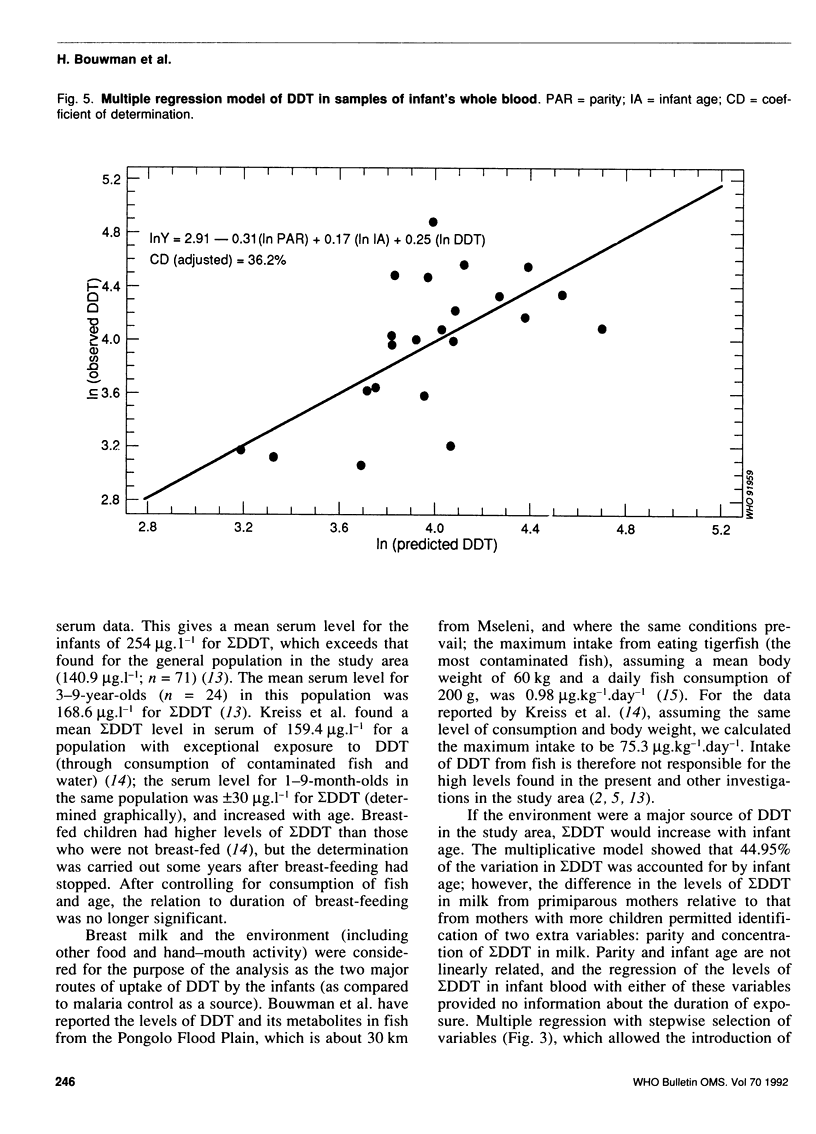
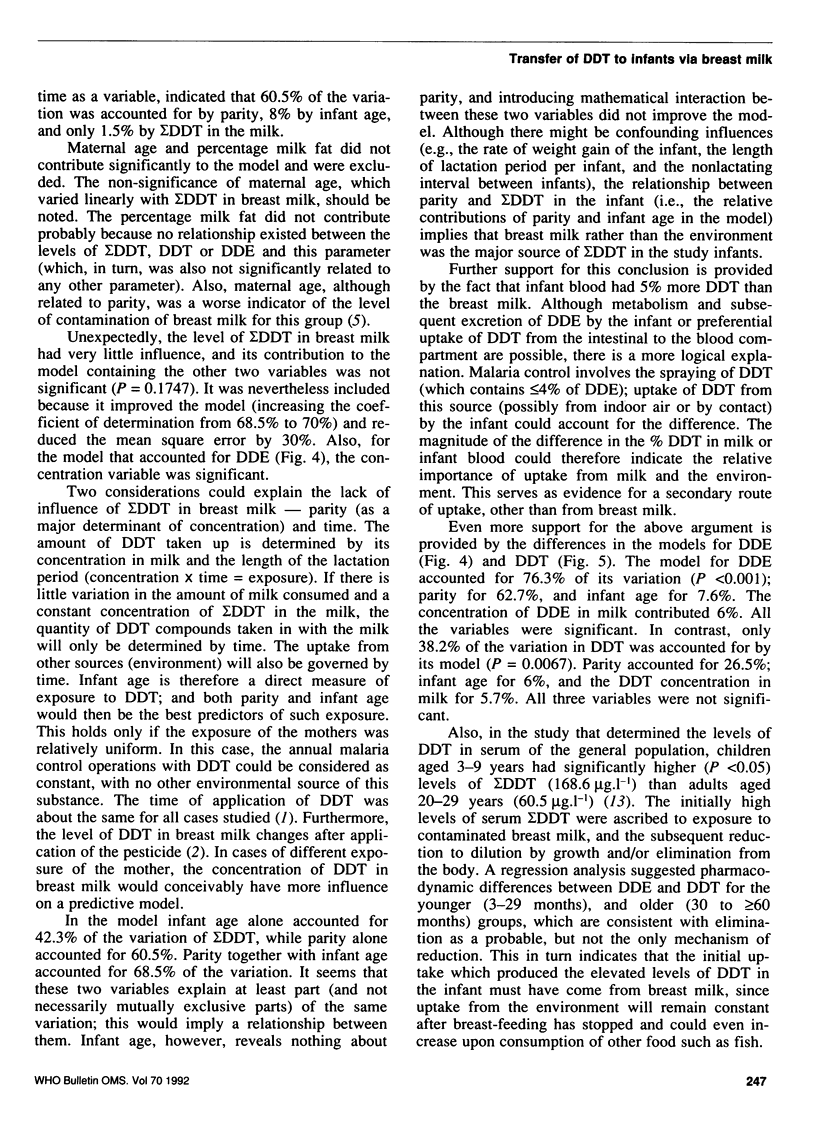

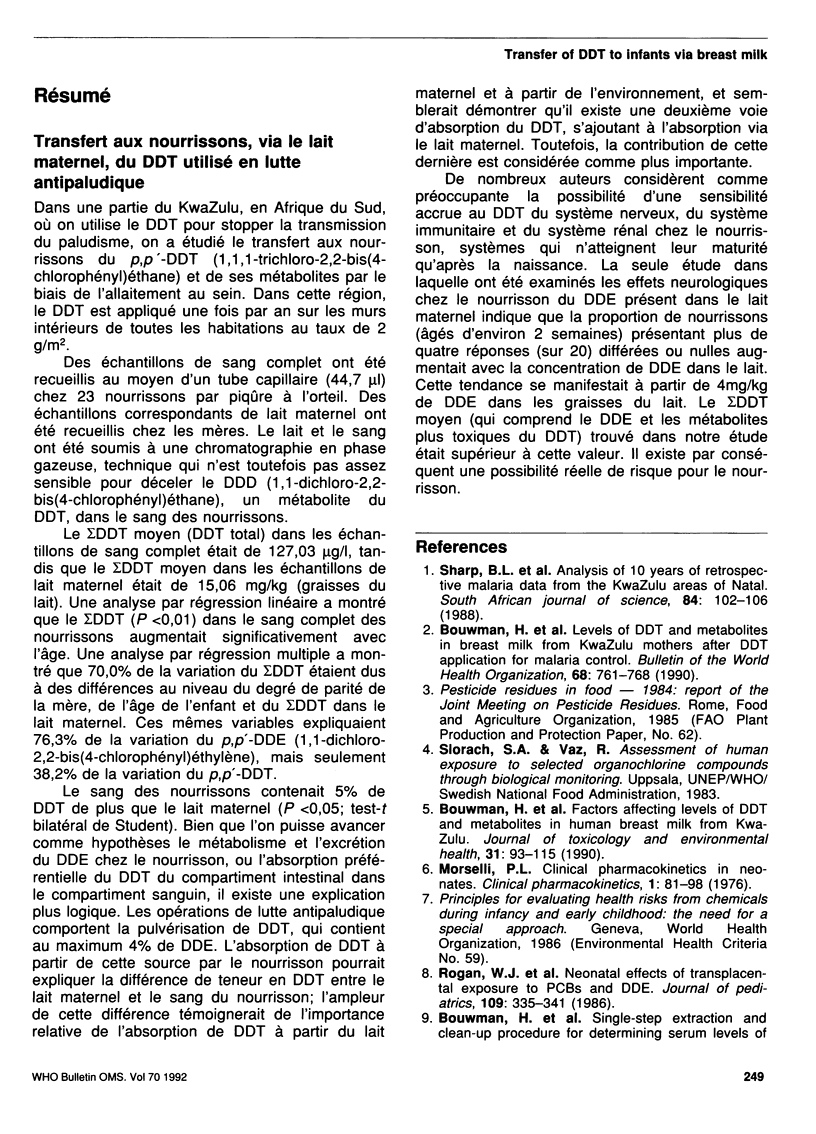
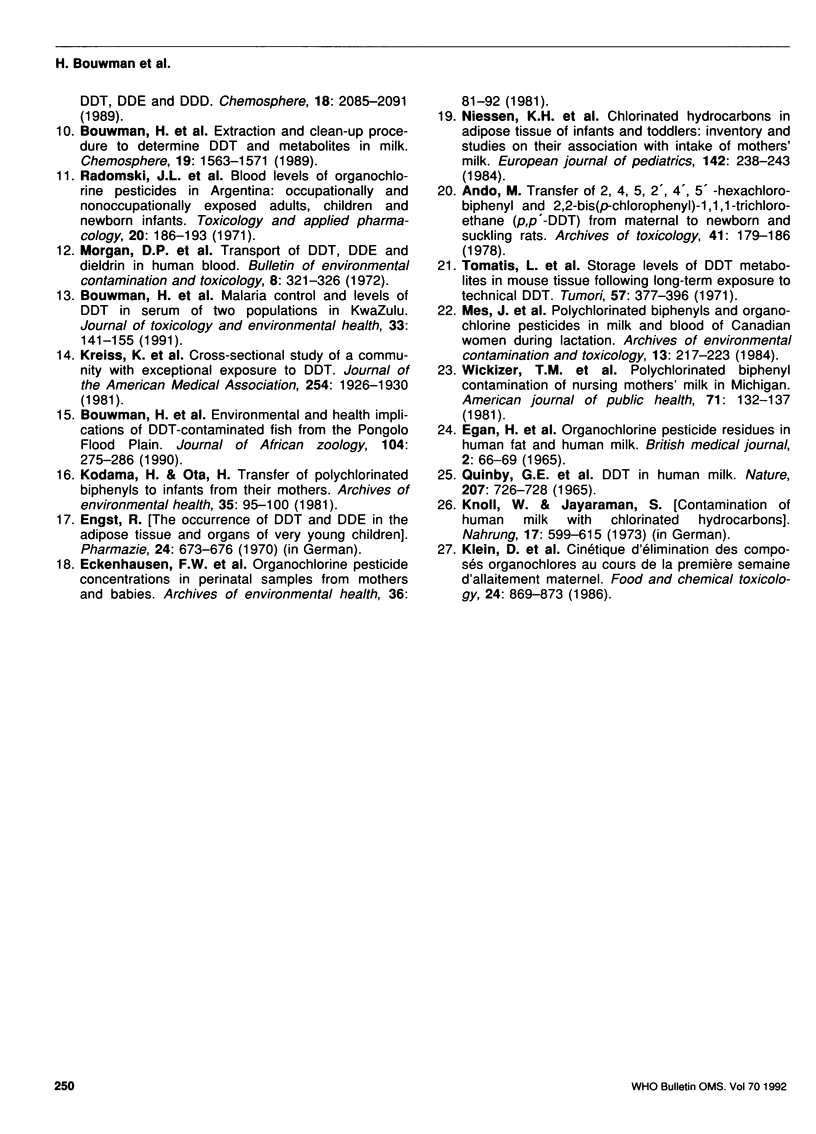
Selected References
These references are in PubMed. This may not be the complete list of references from this article.
- Ando M. Transfer of 2,4,5,2',4',5'-hexachlorobiphenyl and 2,2-bis-(p-chlorophenyl),1,1,1-trichloroethane (p,p'-DDT) from maternal to newborn and suckling rats. Arch Toxicol. 1978 Dec 28;41(3):179–186. doi: 10.1007/BF00354089. [DOI] [PubMed] [Google Scholar]
- Bouwman H., Cooppan R. M., Becker P. J., Ngxongo S. Malaria control and levels of DDT in serum of two populations in Kwazulu. J Toxicol Environ Health. 1991 Jun;33(2):141–155. doi: 10.1080/15287399109531514. [DOI] [PubMed] [Google Scholar]
- Bouwman H., Cooppan R. M., Reinecke A. J., Becker P. J. Levels of DDT and metabolites in breast milk from Kwa-Zulu mothers after DDT application for malaria control. Bull World Health Organ. 1990;68(6):761–768. [PMC free article] [PubMed] [Google Scholar]
- Bouwman H., Reinecke A. J., Cooppan R. M., Becker P. J. Factors affecting levels of DDT and metabolites in human breast milk from Kwazulu. J Toxicol Environ Health. 1990 Oct;31(2):93–115. doi: 10.1080/15287399009531440. [DOI] [PubMed] [Google Scholar]
- EGAN H., GOULDING R., ROBURN J., TATTON J. O. ORGANO-CHLORINE PESTICIDE RESIDUES IN HUMAN FAT AND HUMAN MILK. Br Med J. 1965 Jul 10;2(5453):66–69. doi: 10.1136/bmj.2.5453.66. [DOI] [PMC free article] [PubMed] [Google Scholar]
- Eckenhausen F. W., Bennett D., Beynon K. I., Elgar K. E. Organochlorine pesticide concentrations in perinatal samples from mothers and babies. Arch Environ Health. 1981 Mar-Apr;36(2):81–92. doi: 10.1080/00039896.1981.10667611. [DOI] [PubMed] [Google Scholar]
- Engst R., Knoll R., Nickel B. Uber das Vorkommen von DDT und DDE im Fettgewebe und in Organen von Kleinstkindern. Pharmazie. 1969 Nov;24(11):673–676. [PubMed] [Google Scholar]
- Klein D., Dillon J. C., Jirou-Najou J. L., Gagey M. J., Debry G. Cinétique d'élimination des composés organochlorés au cours de la première semaine d'allaitement maternel. Food Chem Toxicol. 1986 Aug;24(8):869–873. doi: 10.1016/0278-6915(86)90079-7. [DOI] [PubMed] [Google Scholar]
- Kodama H., Ota H. Transfer of polychlorinated biphenyls to infants from their mothers. Arch Environ Health. 1980 Mar-Apr;35(2):95–100. [PubMed] [Google Scholar]
- Mes J., Doyle J. A., Adams B. R., Davies D. J., Turton D. Polychlorinated biphenyls and organochlorine pesticides in milk and blood of Canadian women during lactation. Arch Environ Contam Toxicol. 1984 Mar;13(2):217–223. doi: 10.1007/BF01055879. [DOI] [PubMed] [Google Scholar]
- Morgan D. P., Roan C. C., Paschal E. H. Transport of DDT, DDE, and dieldrin in human blood. Bull Environ Contam Toxicol. 1972 Dec;8(6):321–326. doi: 10.1007/BF01684768. [DOI] [PubMed] [Google Scholar]
- Morselli P. L. Clincial pharmacokinetics in neonates. Clin Pharmacokinet. 1976;1(2):81–98. doi: 10.2165/00003088-197601020-00001. [DOI] [PubMed] [Google Scholar]
- Niessen K. H., Ramolla J., Binder M., Brügmann G., Hofmann U. Chlorinated hydrocarbons in adipose tissue of infants and toddlers: inventory and studies on their association with intake of mothers' milk. Eur J Pediatr. 1984 Sep;142(4):238–244. doi: 10.1007/BF00540242. [DOI] [PubMed] [Google Scholar]
- Quinby G. E., Armstrong J. F., Durham W. F. DDT in human milk. Nature. 1965 Aug 14;207(998):726–728. doi: 10.1038/207726a0. [DOI] [PubMed] [Google Scholar]
- Radomski J. L., Astolfi E., Deichmann W. B., Rey A. A. Blood levels of organochlorine pesticides in Argentina: occupationally and nonoccupationally exposed adults, children and newborn infants. Toxicol Appl Pharmacol. 1971 Oct;20(2):186–193. doi: 10.1016/0041-008x(71)90044-5. [DOI] [PubMed] [Google Scholar]
- Rogan W. J., Gladen B. C., McKinney J. D., Carreras N., Hardy P., Thullen J., Tinglestad J., Tully M. Neonatal effects of transplacental exposure to PCBs and DDE. J Pediatr. 1986 Aug;109(2):335–341. doi: 10.1016/s0022-3476(86)80397-3. [DOI] [PubMed] [Google Scholar]
- Tomatis L., Turusov V., Terracini B., Day N., Barthel W. F., Charles R. T., Collins G. B., Boiocchi M. Storage levels of DDT metabolites in mouse tissues following long term exposure to technical DDT. Tumori. 1971 Nov-Dec;57(6):377–396. doi: 10.1177/030089167105700603. [DOI] [PubMed] [Google Scholar]
- Wickizer T. M., Brilliant L. B., Copeland R., Tilden R. Polychlorinated biphenyl contamination of nursing mothers' milk in Michigan. Am J Public Health. 1981 Feb;71(2):132–137. doi: 10.2105/ajph.71.2.132. [DOI] [PMC free article] [PubMed] [Google Scholar]


